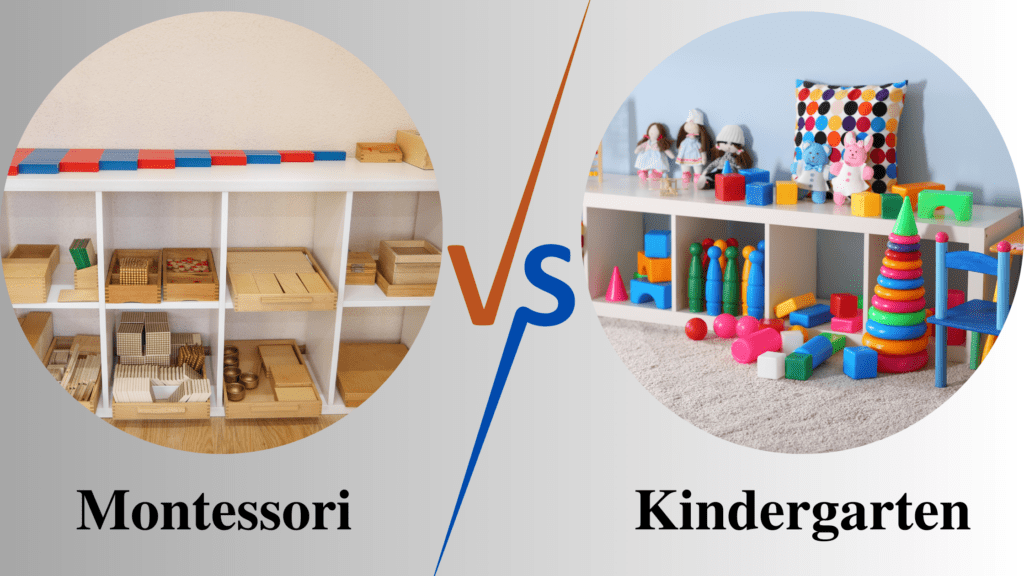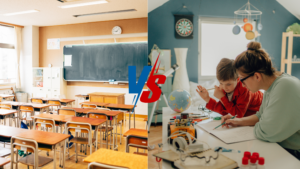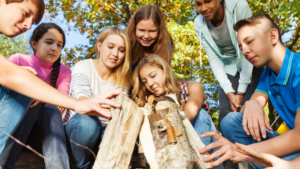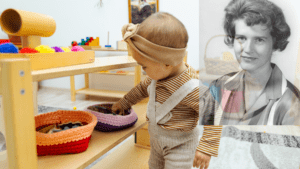Choosing a school for your child is a big decision, and it can be overwhelming to navigate the many types of educational systems that are available. Two popular options are Montessori schools and Kindergarten schools.
Before children start formal schooling, both kindergarten and a Montessori environment place an emphasis on giving them a foundational education. Their methods when it comes to educating children are what set them apart from one another. While a Montessori school aims to foster habits of natural learning in the children, kindergartens frequently make learning enjoyable and engaging for the children who attend.
Let us understand the key differences between these two different types of learning methodology.
Kindergarten Schools
Kindergarten is an academic program offered to children between the ages of three and five. In a kindergarten, teaching methods are so individually tailored that children like their learning instantly. Children learn social skills including self-worth and self-control in kindergarten.
In addition to emphasizing the development of a child’s academic skills, kindergartens make sure that children have enough recreation. Kindergarten often provides a more formal education after which a child starts their first year of formal education at a school.
- Philosophy
Kindergarten is a typical educational strategy utilized in many schools as a component of the educational system. In kindergarten, the educational system is restricted. The job of the teacher is predetermined, and all children are taught using the same methodology. The teacher is the center of attention and selects the methods of instruction. They determine what, when, and how students acquire a subject or skill.
- Curriculum
As a child is enrolled in kindergarten, the learning begins. Basic concepts like reading, writing, counting, and more are taught in day-to-day classes. Crucial social skills and adjusting in a classroom or school are also learned by the child. The pre-defined curriculum as per the class prepares the child for the future topics in each subject.
At the end of kindergarten, a child is able to read books, do basic math, identify the change in weather, and comprehend simple procedures of science. The child is able to follow instructions as given by the teachers, follow turns, and be considerate of others.
- Classroom Environment
The focus on the teacher, the pre-defined curriculum, and the structured system make the kindergarten setting more passive. All the children are expected to learn at the same pace and those who are not able to cope with the method are left behind. The pride and self-esteem spring from the achievements in the assessments in the kindergarten model of education.
Are you curious to know how to strengthen your child’s emotional intelligence? Check out our detailed blog here!
Montessori Schools
Maria Montessori, an Italian educator, established the Montessori Method of education. Her teachings are valued till date and are practiced in many schools across the globe. In a Montessori Method, the focus is on the child’s development be it mental, physical, or emotional. It is a method that ‘educates’ the child.
The children can express themselves and learn in a natural environment. Montessori believed that children learn best through hands-on experiences and self-directed exploration. Montessori education begins at the age of 2 and continues through the teenage years to adult.
The Montessori style uses an unstructured approach where each student is allowed to express themselves and the teacher adapts to the students’ style.
- Philosophy
The Montessori Method of education encourages the development of children’s physical, social, and emotional needs, as well as highly autonomous learning and mixed-age classes. According to the Montessori approach, kids have an inherent drive to learn. Each student in the classroom receives personalized attention in a Montessori classroom.
It gives children the chance to learn at their own, developmentally appropriate pace. The creation of specially and carefully designed learning environments encourages children to pursue their own interests in learning.
- Curriculum
Regardless of a child’s developmental stage, the curriculum is built around that child’s inclination for activity. This curriculum serves as the foundation for the Montessori curriculum, which promotes the development of the complete child.
The Montessori Preschool Curriculum places a special emphasis on children between the ages of infancy and three and encourages them to accept their innate desire for independence. Along with improving fine and gross motor skills and language development, one of the curriculum’s main focuses is on the child’s ability to move.
When participating in lessons, toddlers are also urged to develop politeness and decency. Most Montessori preschool curriculums include practical life, sensorial, and cognitive lessons.
- Classroom Environment
In a Montessori classroom, the teachers serve as a guide. They do not determine how or what the children learn. They only offer a subject to children and let them investigate the different solutions to that specific topic or issue. The design of a Montessori classroom places the child at the center and is based on observations of children’s behavior.
It enables individualized and targeted learning. Children’s special spiritual demands require a nurturing, loving adult who can show respect for both the child and childhood. The Montessori program is not dependent on the grades and class-wise learning. The foundation of any Montessori program is a mixed-age group of children. In all Montessori classrooms, multi-age grouping is used instead of single grades.
Also Check: Role of a Community in a Montessori Education
Difference between Montessori and Kindergarten
The main difference between Montessori and Kindergarten schools are their teaching methods, curriculum, and classroom environment.
| Kindergarten Schools | Montessori Schools | |
| Focus | Structured learning | Developing child senses and natural abilities |
| Teaching Methods | The focus is on preparing the children for later academic success. The teacher sets the curriculum and learning objectives and guides the students through the activities. The children learn as per the pre- designed guided plan. | Focus on hands-on learning and self-directed exploration, The children are encouraged to learn through their own experience and curiosity. The Montessori approach is centered on the child’s interest, and the teacher’s role is to guide and support the child’s learning process. |
| Curriculum | The curriculum is designed to prepare the children for later academic success and is standardized across schools. It is typically more structured with a focus on basic skills such as reading, writing, and arithmetic. | The curriculum is based on the child’s interest. It is individualized and self-paced, allowing children to learn at their own speed and in their own way. It is designed to promote independence, creativity, and critical thinking skills. |
| Classroom Environment | The kindergarten classroom is designed to be a structured and organized space that is conducive to learning. Children are typically seated at desks and expected to listen to the teacher and follow directions | The Montessori classroom is designed to be a peaceful and orderly space. Children are free to move around the classroom and choose their own activities, which are typically displayed on low shelves. The children are encouraged to take care of their environment. |
Conclusion
Whether to select a Montessori school or a typical play-based preschool, you must consider your child’s goals and feel at ease with your decision. Do thorough studies, consider the advantages and drawbacks, and then decide wisely based on the information gathered.
An excellent idea is to spend a day with the child in any preschool as per the consideration and check where the child performs better in all the ways. As the child has to go to school every day, the child’s behavior in the school setting is crucial to consider, though it shouldn’t be the only factor during selection.
Speaking with the parents of other students is another way to make the final decision. This will significantly assist in concluding the choice of the school. After all, the best kind of review is still word of mouth, especially in today’s extremely internet-oriented society.




